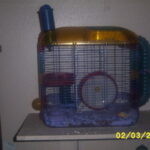Store-bought rabbit cages tend to be extremely overpriced and flimsy, especially if you’ve got your heart set on one of the many “luxury” rabbit cages that offer extra space and comfort for your pet as an excuse for charging hundreds of dollars more. The cheaper, easier, and sturdier solution is to just build one yourself. This simple guide will teach you how to build your very own multi-level, “condo” style rabbit cage right at home and on a budget, using materials available at any common department, home improvement, or crafts store for next to nothing.
Supplies:
-1-2 boxes of connectable wire storage cubes
-1 large pack of zip-ties, non-reversible
-1 small pack of zip-ties, reversible (for the lock on the door, you’ll only need one to start, but you’ll want extras)
-A hard, smooth surface to put the cage on (and some extra, to line the optional shelves with)
-A pair of scissors
Building the Cage
1) Fasten the wire squares together into your desired cage’s size and shape using sturdy zip-ties. The bigger the better, as long as you’ve got space. Be sure to leave at least one square in front unattached on one side, as a door hinge – you don’t want to have to lift the whole thing off the ground any time Mr. Cadbury wants out, after all.
2) Add a ‘shelf’ or ‘ledge’ inside (if desired) using some additional squares, and fasten it securely to the walls with more zip-ties. Don’t panic if it doesn’t seem stable enough to support your rabbit’s full weight just yet; step 4 will deal with that. This will be your rabbit’s ‘second floor,’ and depending on the dimensions of your cage, you may feel like adding even more to your bunny’s new floor-plan – if so, great! It’s extremely easy to do, and the more nooks and crannies your rabbit has to hop around between, the happier he’ll be.
3) Place the whole structure on top of an appropriate hard surface – I find that cutting down a large sheet of plywood works well, providing a cool and easy-to-clean surface for your bunny to lay and play on. You can also glue the leftover strips of plywood around the edges for a four to five inch lip to keep all the messy debris of loose fur and stray pellets where it belongs – inside the cage. A simple linoleum mudroom or laundry room floor will also work, if you have one with room to spare.
4) Slide a wooden dowel through the walls underneath the middle and edges of any additional shelves (and ceiling, if necessary) to provide additional support. Next, cover all your shelves with a smooth surface to keep the rabbit’s feet off the wire – you can use cardboard, more plywood, spare linoleum, or any similar material, as long as it is either heavy enough to stay in place on its own or can be secured to the shelf some other way.
5) Use another reversible zip-tie as a ‘lock’ for the door, then finish things up by clipping off the ends of all the other zip-ties around the cage – try to leave as little excess plastic for the rabbit to chew and as few sharp edges as possible.






